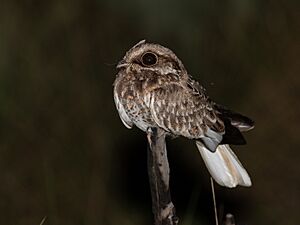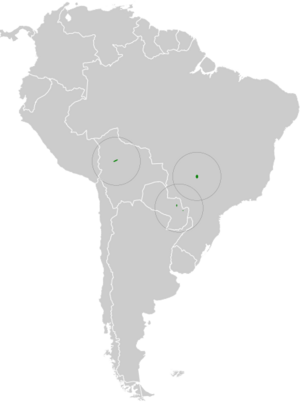White-winged nightjar facts for kids
Quick facts for kids White-winged nightjar |
|
|---|---|
 |
|
| Conservation status | |
| Scientific classification | |
| Genus: |
Eleothreptus
|
| Species: |
candicans
|
 |
|
The white-winged nightjar (Eleothreptus candicans) is a special type of nightjar bird. It belongs to the Caprimulgidae family. You can find this bird in Bolivia, Brazil, and Paraguay.
Contents
What Does It Look Like?
The white-winged nightjar is about 19 to 23 cm (7.5 to 9.1 in) long. That's about the length of a ruler! Both male and female adult birds weigh around 46 to 55 g (1.6 to 1.9 oz). This is about the weight of a small apple.
Adult male nightjars have pale grayish-brown feathers on their upper body. They have dark spots on their head and brown stripes and speckles everywhere else. Their face is mostly brown, but they have a white stripe above their eye and a white "moustache." Their chest is grayish-brown with a hint of red-brown. The rest of their belly is white. When they fly, you can see their whitish wings and mostly white tail.
Female nightjars look a bit different. They have buff-colored (light yellowish-brown) feathers on their belly. They do not have any white feathers on their wings or tail. Young nightjars are more brown than grayish.
Where Does It Live?
The white-winged nightjar lives in a few different places. It has been seen in northern Bolivia, central-south Brazil, and eastern Paraguay. There are also old records of it living in southern Brazil.
This bird likes to live in open grasslands. These areas have scattered trees and bushes. It enjoys places like savannas and a type of grassland called cerrado. You can find them from sea level up to about 210 m (690 ft) high.
How It Lives
Does It Travel?
Scientists think the white-winged nightjar might travel a lot. It could be a migratory bird in some parts of its home range. This means it moves from one place to another during different seasons.
What Does It Eat?
The white-winged nightjar mostly hunts for food while flying low. It also sometimes flies out from a low branch to catch insects. Its flight is usually slow, and it often glides through the air. It eats insects like beetles and moths.
Reproduction and Family Life
The very first nest of a white-winged nightjar was found in 1997. Female nightjars lay two eggs directly on the ground. In Paraguay, they lay eggs from mid-September to mid-November. Only the female bird sits on the eggs to keep them warm.
Male nightjars do a special flight to show off their white wings and tail. This display helps them protect their territory. It also helps them attract a mate.
What Sounds Does It Make?
Male white-winged nightjars make a soft call. It sounds like "tshere-she-shew." They make this sound when they are chasing other birds away from their territory. Their display flights also make mechanical wing noises. When they are alarmed, they make a sudden "eek" sound.
Is It Safe?
The IUCN (International Union for Conservation of Nature) keeps track of how safe animal species are. The white-winged nightjar's status has changed over time. It was once considered "Threatened." Then it became "Critically Endangered" and "Endangered." Since 2019, it has been listed as "Vulnerable."
This means there are not many white-winged nightjars left. They are only found in a few scattered places. The biggest dangers to these birds are:
- Their habitat being turned into farms (for crops or trees like Eucalyptus).
- Fires in their grassland homes.
Protecting their habitat is very important to help these unique birds survive.


